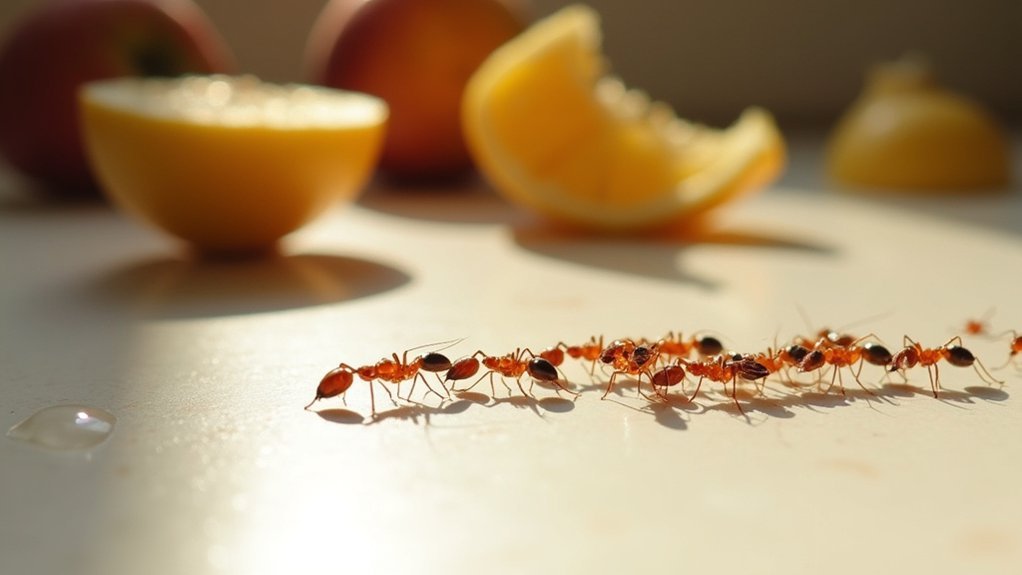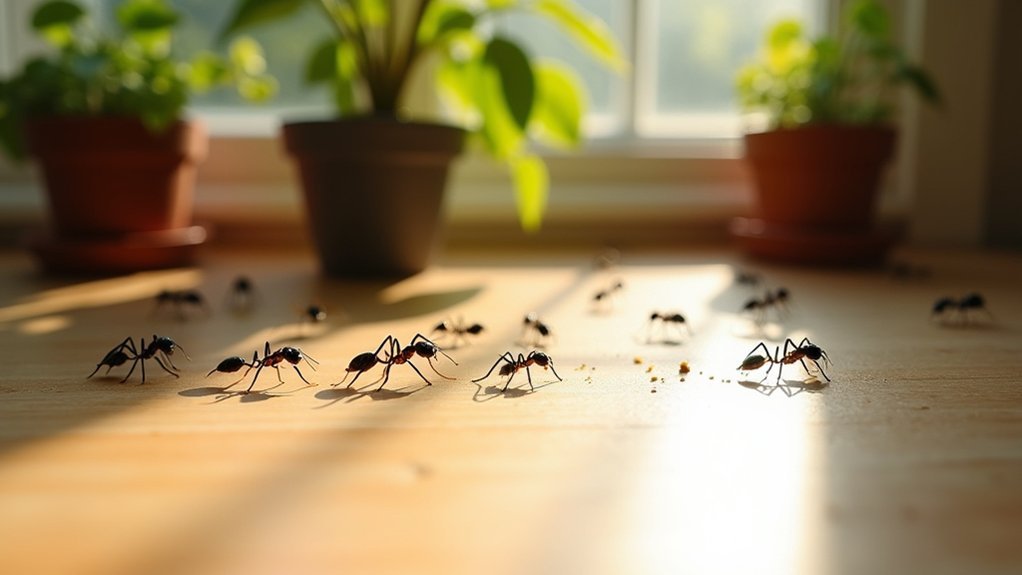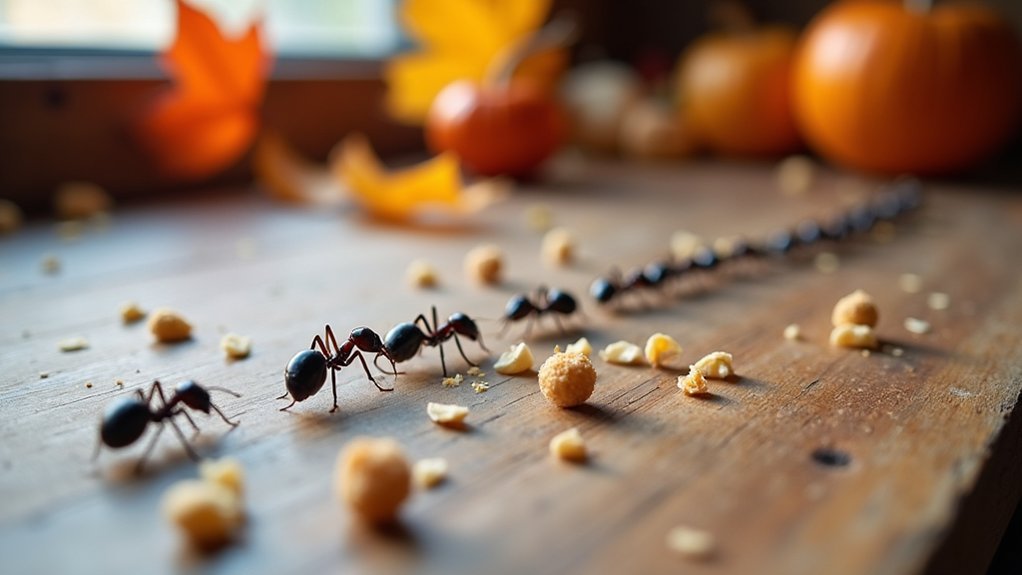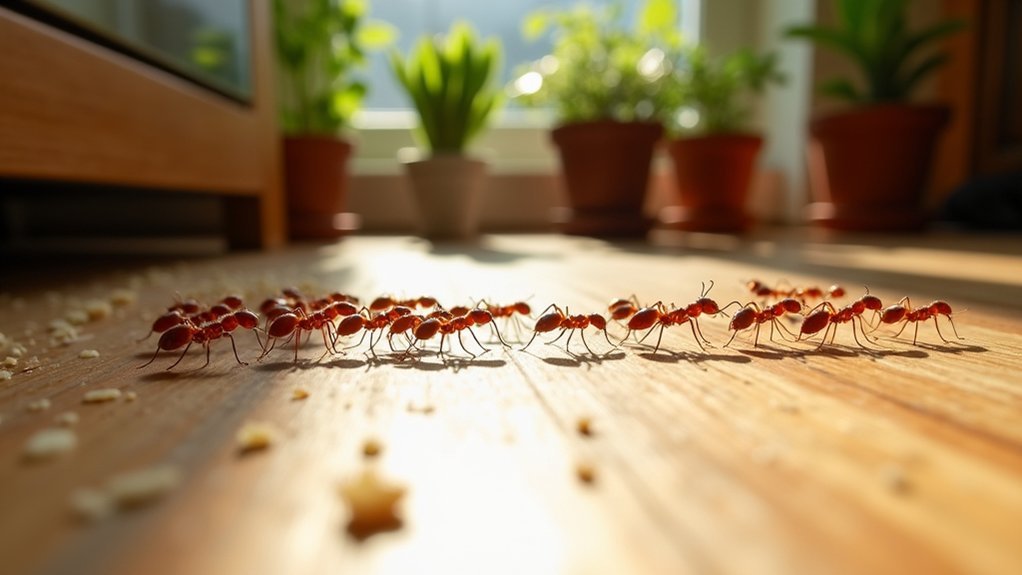Ants invade your home for different reasons as seasons change. In spring, they awaken hungry after winter dormancy. Summer drives them inside seeking moisture and relief from heat. Fall triggers survival instincts, pushing larger groups indoors for shelter. Even winter doesn’t stop them, as indoor colonies thrive on your home’s warmth and resources. Understanding these seasonal patterns helps you anticipate and prevent infestations before they establish their tiny foothold in your living spaces.
Understanding Seasonal Ant Behavior Patterns

While you might notice ants only when they’re marching across your kitchen counter, these persistent insects follow distinct seasonal patterns that determine when and why they invade your home.
As weather warms in spring, colonies awaken and begin foraging, often making your home their first target.
Summer brings peak ant activity as they search for moisture and food sources during hot, dry periods.
Fall triggers survival instincts, with species like odorous house ants entering in larger numbers to gather provisions before winter.
Don’t be fooled by winter’s apparent calm—indoor colonies remain active year-round, utilizing your home’s warmth and resources.
By February, you’ll likely notice increased activity as indoor populations grow.
To prevent ants, implement year-round moisture control and eliminate food sources, understanding that each season presents different challenges.
Spring Invasion: Why Ants Enter Homes After Winter
After months of relative quiet, spring triggers a dramatic shift in ant behavior that often leads straight to your doorstep. As temperatures start rising, ant colonies awaken from winter dormancy, sending worker ants on aggressive foraging missions to replenish depleted resources.
- Your home provides ideal conditions – consistent warmth, moisture, and abundant food sources that attract ants seeking to support their expanding colonies.
- Even tiny food remnants in your kitchen become beacons for scout ants, who lay down chemical trails that quickly mobilize an entire workforce.
- The spring invasion coincides with colony expansion, as queens increase egg production and colonies seek new nesting locations.
You’ll typically notice this seasonal surge when trails of worker ants suddenly appear in your kitchen or bathroom, signaling the beginning of ant season.
Summer Surge: Managing Peak Ant Activity Naturally

You’ll notice ants invading your home more aggressively during summer’s peak temperatures as they seek cooler environments and essential water sources.
Their intensified search for moisture makes your kitchen sinks, bathroom drains, and any water-prone areas particularly attractive targets during dry spells.
Combat this natural migration by implementing scent barriers with peppermint oil, vinegar solutions, or coffee grounds around entry points—these natural deterrents disrupt ant pheromone trails without introducing harmful chemicals into your living space.
Heat Drives Indoor Migration
As summer temperatures rise, ants begin their predictable migration into your home, seeking refuge from the scorching outdoor heat.
During summer months, ants come indoors in greater numbers, creating pest problems that can quickly escalate. The intense heat drives their search for food and water, as their natural resources become scarce outdoors.
You’ll notice ants become more active in moisture-rich areas like:
- Kitchens where crumbs and food residue provide easy meals
- Bathrooms where water sources are readily available
- Pantries where stored food offers sustenance for growing colonies
When dry conditions persist outside, worker ants invade homes following strong pheromone trails that lead to your resources.
As colonies expand in summer, more scouts discover entry points, turning a few random ants into full-scale invasions.
Water-Seeking Behavior Intensifies
Three distinct patterns emerge when summer heat drives ant colonies to seek water inside your home.
First, you’ll notice ants invade kitchens and bathrooms where moisture is abundant, creating trails to water sources they’ve discovered.
Second, leaky faucets and areas with high humidity become prime targets, as dehydrated colonies send more scouts to locate and report these oases.
Third, ant activity markedly increases around condensation points on pipes and windows where they can collect droplets.
To implement effective ant prevention during this summer surge, focus on eliminating their water access.
Fix dripping taps immediately, reduce indoor humidity with proper ventilation, and wipe down wet surfaces in bathrooms after showering.
Remember that addressing water sources is often more effective than pesticides alone when tackling summer ant invasions.
Natural Deterrent Strategies
While chemical pesticides might seem like a quick solution during summer’s ant surge, natural deterrents offer effective and family-friendly alternatives. Ants love moisture and food scraps, so keeping your home clean and storing food in airtight containers naturally discourages their presence.
- Use vinegar or citrus essential oils to disrupt ant trails and create barriers they won’t cross.
- Plant mint around entry points or apply diatomaceous earth along baseboards for safe, natural control solutions.
- Reduce humidity by fixing leaks and ensuring proper ventilation, making your home less appealing to moisture-seeking ants.
Regular inspections of your home’s perimeter allow you to spot and seal potential entry points before infestations begin.
Fall Foraging: Preparing Your Home Against Autumn Ant Invasions

When temperatures begin to drop, ants shift into high gear with increased foraging activities, making your home a prime target for invasion.
During autumn, odorous house ants particularly seek indoor shelter and food supplies as they prepare for winter survival. You’ll notice more aggressive fall foraging behavior, sometimes even witnessing swarms as new queens establish colonies.
Fall brings desperate house ants seeking refuge in your home before winter strikes.
To prevent ant infestations before they become spring problems, you’ll need to act quickly. Secure all food sources in airtight containers and clean up crumbs immediately.
Carefully inspect and seal entry points around windows, doors, and foundation cracks. Regular cleaning eliminates chemical trails ants follow to find resources.
Taking these preventative measures during autumn will markedly reduce the likelihood of ants invading your home when temperatures drop.
Winter Warmth Seekers: Keeping Indoor Ants at Bay
During winter, ants don’t truly hibernate but seek warm indoor spaces like your walls and crawl spaces for survival.
You’ll notice these persistent pests following specific heat pathways into your home, often clustering near heating vents, water heaters, or under appliances.
Even during their less active winter period, you can prevent indoor infestations by sealing entry points, wiping down counters, and storing food in airtight containers.
Indoor Winter Survival
As temperatures plummet outside, your cozy home becomes an irresistible sanctuary for ants seeking refuge from the harsh winter elements.
Winter ant infestations often develop silently as these resilient creatures establish nests within your walls, behind cabinets, or in crawl spaces where they find ideal conditions to survive.
You’ll likely miss early signs of indoor ant activity during winter since they remain hidden while establishing colonies.
What attracts them most? Your home provides everything they need:
- Warmth from your heating system that keeps their colonies active when outdoor ants become dormant
- Moisture sources, particularly around leaky pipes or humid bathrooms
- Food remnants in kitchens and pantries that offer sustenance when natural food is scarce
To protect your home, maintain dry conditions, seal entry points, and eliminate food sources immediately.
Heat-Seeking Behavior Patterns
Ants possess remarkably sophisticated heat-detection systems that guide their winter survival strategies. During the winter months, you’ll notice these tiny invaders following thermal gradients directly to your home’s heat sources. They’re particularly drawn to your central heating system, which provides an ideal environment when outdoor temperatures plummet.
| Location | Why Ants Choose It | Prevention Tips |
|---|---|---|
| Kitchen | Food crumbs and warmth | Clean spills immediately |
| Bathroom | Moisture and heat | Fix leaky faucets |
| Walls | Insulation protection | Seal entry points |
| Cabinets | Food proximity | Store food in containers |
| Crawl spaces | Undisturbed nesting | Regular pest control inspection |
February’s temperature fluctuations often trigger increased activity as colonies break dormancy. You’ll find them establishing nests in walls and behind appliances, where they can simultaneously access both warmth and foraging opportunities—making thorough pest control essential during winter.
Prevention During Dormancy
When winter temperatures drop, your warm home becomes an irresistible sanctuary for ant colonies seeking shelter from the cold.
To prevent these unwanted winter guests, focus on eliminating entry points and removing attractants that make your home appealing to ants.
- Seal all cracks, gaps around windows, doors, and utility lines where ants can enter, paying special attention to areas near kitchens and bathrooms.
- Maintain strict cleanliness by wiping up spills immediately, storing food in airtight containers, and emptying trash regularly.
- Keep storage areas dry and organized, inspecting them periodically for signs of activity, especially in warm spots like areas near water heaters or behind appliances.
Natural Deterrents for Each Season’s Unique Ant Challenges
The changing seasons bring distinct ant challenges to homeowners, each requiring specific natural deterrents to maintain an ant-free environment.
In spring, prevent ant infestation by sealing entry points and maintaining cleanliness to deter common culprits awakening from winter dormancy.
Summer calls for natural repellents like vinegar and essential oils to combat heat-stressed ants seeking moisture and food indoors.
Fall protection comes from creating barriers with diatomaceous earth around potential entry points, stopping odorous house ants from stockpiling winter supplies in your home.
During winter, address moisture issues by fixing leaks that attract indoor colonies.
For long-term protection, implement year-round habits like regular outdoor inspections, debris removal, and vegetation management to minimize ant populations before they become problematic.
Creating Seasonal Barriers With Kitchen Ingredients
Since most homeowners already possess effective ant deterrents in their pantry, creating seasonal barriers with common kitchen ingredients offers a convenient and non-toxic approach to pest management.
When ants invade during warmer months, vinegar solutions can disrupt their pheromone trails, preventing scouts from guiding others into your home.
- Mix essential oils like peppermint or tea tree with water to spray around entry points, creating an aromatic shield ants won’t cross.
- Sprinkle cinnamon along windowsills and doorways to establish a natural barrier that repels ants with its potent scent.
- Create seasonal barriers with a water-baking soda mixture around perimeters, which disrupts ant digestive systems when ingested.
For persistent problems, try food-grade diatomaceous earth, which dehydrates ants upon contact while remaining safe for household use.
Year-Round Prevention Strategies Using Plant-Based Repellents
Why rely on toxic chemicals when nature provides powerful ant deterrents that work throughout all seasons?
Plant-based repellents offer effective, eco-friendly solutions for year-round protection against ant invasions.
Nature’s wisdom provides safer alternatives to harsh chemicals, protecting your home with plant power in every season.
Create your own DIY repellent by mixing water with essential oils like tea tree, eucalyptus, or peppermint. Apply this solution regularly to entry points such as doorways and windows as part of your seasonal prevention routine.
These natural compounds disrupt pheromone trails that ants use for navigation.
For continuous protection, strategically place citrus peels near vulnerable areas or spray vinegar along baseboards.
You’ll also benefit from planting natural deterrents like mint and marigolds around your home’s perimeter.
These not only repel ants but enhance your landscaping.
Frequently Asked Questions
What Month Are Ants the Worst?
You’ll find ants are typically worst during June and July when they’re most active. Their populations peak in summer as they’re aggressively searching for food and moisture in your home.
Is It Normal for Ants to Be in Your House During Summer?
Yes, it’s completely normal to see ants in your house during summer. They’re seeking water and food to escape the heat outside. You’ll notice increased activity as they follow pheromone trails to resources.
Why Am I Suddenly Getting Ants in the House?
You’re suddenly seeing ants because they’ve found food, water, or shelter in your home. Spring warmth, summer heat, or fall preparation triggers their search, and once they discover resources, they’ll keep coming back.
What Time of Year Do Ants Come Into Your House?
You’ll typically find ants invading your house during spring when they awaken, summer when they seek moisture, fall as they gather supplies, and even winter if they’ve established indoor nests. February often shows increased activity.
In Summary
By understanding why ants invade your home in different seasons, you’ll stay one step ahead of these persistent pests. Remember, each season brings unique challenges—spring’s moisture seekers, summer’s food hunters, fall’s shelter finders, and winter’s warmth lovers. With natural deterrents tailored to seasonal behaviors, you’re not just responding to infestations; you’re preventing them. Keep your defenses up year-round, and you’ll enjoy an ant-free home regardless of the weather.





Leave a Reply